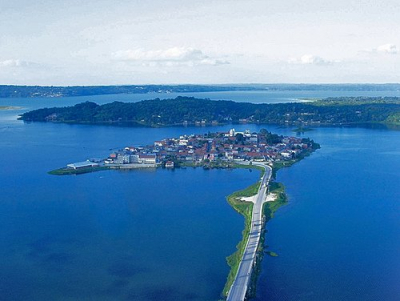In a protracted conflict during the Spanish colonization of the Americas, Spanish colonisers gradually incorporated the territory that became the modern country of Guatemala into the colonial Viceroyalty of New Spain. Before the conquest, this territory contained a number of competing Mesoamerican kingdoms, the majority of which were Maya. Many conquistadors viewed the Maya as "infidels" who needed to be forcefully converted and pacified, disregarding the achievements of their civilization. The first contact between the Maya and European explorers came in the early 16th century when a Spanish ship sailing from Panama to Santo Domingo was wrecked on the east coast of the Yucatn Peninsula in 1511. Several Spanish expeditions followed in 1517 and 1519, making landfall on various parts of the Yucatn coast. The Spanish conquest of the Maya was a prolonged affair; the Maya kingdoms resisted integration into the Spanish Empire with such tenacity that their defeat took almost two centuries.Pedro de Alvarado arrived in Guatemala from the newly conquered Mexico in early 1524, commanding a mixed force of Spanish conquistadors and native allies, mostly from Tlaxcala and Cholula. Geographic features across Guatemala now bear Nahuatl placenames owing to the influence of these Mexican allies, who translated for the Spanish. The Kaqchikel Maya initially allied themselves with the Spanish, but soon rebelled against excessive demands for tribute and did not finally surrender until 1530. In the meantime the other major highland Maya kingdoms had each been defeated in turn by the Spanish and allied warriors from Mexico and already subjugated Maya kingdoms in Guatemala. The Itza Maya and other lowland groups in the Petn Basin were first contacted by Hernn Corts in 1525, but remained independent and hostile to the encroaching Spanish until 1697, when a concerted Spanish assault led by Martn de Ursa y Arizmendi finally defeated the last independent Maya kingdom.
Spanish and native tactics and technology differed greatly. The Spanish viewed the taking of prisoners as a hindrance to outright victory, whereas the Maya prioritised the capture of live prisoners and of booty. The indigenous peoples of Guatemala lacked key elements of Old World technology such as a functional wheel, horses, iron, steel, and gunpowder; they were also extremely susceptible to Old World diseases, against which they had no resistance. The Maya preferred raiding and ambush to large-scale warfare, using spears, arrows and wooden swords with inset obsidian blades; the Xinca of the southern coastal plain used poison on their arrows. In response to the use of Spanish cavalry, the highland Maya took to digging pits and lining them with wooden stakes.
Nojpetén (also spelled Noh Petén, and also known as Tayasal) was the capital city of the Itza Maya kingdom of Petén Itzá. It is located on an island in Lake Petén Itzá in the modern department of Petén in northern Guatemala. The island is now occupied by the modern town of Flores, the capital of the Petén department, and has had uninterrupted occupation since pre-Columbian times. Nojpetén had defensive walls built upon the low ground of the island, which may have been hastily constructed by the Itza at a time when they felt threatened either by the encroaching Spanish or by other Maya groups.

1697Mar, 13
Nojpetén, capital of the last independent Maya kingdom, fell to Spanish conquistadors, the final step in the Spanish conquest of Guatemala.
Choose Another Date
Events on 1697
- 13Mar
Spanish conquest of Guatemala
Nojpetén, capital of the last independent Maya kingdom, fell to Spanish conquistadors, the final step in the Spanish conquest of Guatemala. - 7May
Stockholm Palace
Stockholm's royal castle (dating back to medieval times) is destroyed by fire. It is replaced in the 18th century by the current Royal Palace. - 5Sep
Battle of Hudson's Bay
War of the Grand Alliance : A French warship commanded by Captain Pierre Le Moyne d'Iberville defeated an English squadron at the Battle of Hudson's Bay.

 English
English  español
español  français
français  português
português  русский
русский  العربية
العربية  简体中文
简体中文 